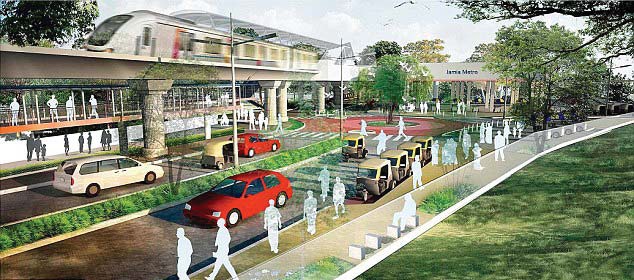The recently launched Smart City Mission, with a total fi nancial grant of INR 48,000 crore for the period 2015-20, intends to cover 100 cities. Select Indian cities will have to prepare a Smart City Plan (SCP), which mandates the inclusion of area based development plans (including redevelopment, retrofitting and Greenfield development) and pan-city initiatives. The pan-city interventions will focus on offering city-wide and inclusive solutions to urbanisation challenges by making use of smart solutions for better use of city infrastructure and services in transport, water, energy, safety, environment and health.
As a prelude to the smart solutions, the implementation of Intelligent Transport Systems (ITS) for traffi c management, smart parking and integrated multi-modal transport have been listed as some of the initiatives.
ITS is the application of advanced technologies (information and communication technologies) which aid in alleviating traffi c congestion, assist inefficient mobility (passenger and goods) and enable efficient use of urban transport infrastructure. The use of ITS applications may vary for various stakeholders.
Some examples of situations where ITS has played a key role in aiding decisions are:
• Commuters –Making travel-related decisions (if, when, and how), choosing transportation options, accessing public transport timings, viewing ride-sharing options, etc.
• Traffic Police –Tracking traffic rule violations, communicating incident information, clearing traffic congestion, etc.
• Other government stakeholders-Implementing demand management measures, identifying major (air) polluted zones due to traffic, ensuring the citizens’ safety etc.
• Public transport organisations – Using smart cards, developing a passenger information system, tracking public transport vehicle, financial planning, etc.
• ITS Vendors –Identifying hardware and software requirements for compatibility and scalability.
The National Urban Transport Policy emphasises the importance of ITS for urban traffic management and monitoring. ITS applications have also been promoted extensively through JNNURM funding, wherein public transport systems are equipped with ITS technologies such as Global Positioning Systems (GPS) and Passenger Information Systems.
Using ITS data in planning and decision making
Pan-city focus is key to unleashing the true potential of ITS interventions in India. The focus of ITS should be on providing city-wide solutions to make effective use of existing infrastructure and promote smart urban mobility. ITS applications (for various purposes) should act as a network for the collection of real-time data which is a key component of any planning process. The collection of various types of data such as parking related, real-time traffic, public transport operations, etc. must be reliable and accurate so as to understand current mobility trends.
Therefore, standards are to be developed that enable interoperability and integration, create well designed information models for data sharing while ensuring privacy and consistency in the data collected by multiple stakeholders. An effective way of ensuring this would be to create a common platform where the data from all sources can be collected and analysed for better planning and decision making.
ITS can play an enabling role in the implementation of sustainable mobility interventions such as travel demand management, improved accessibility to public transit and safety assurance. In cities like London and Singapore, ITS has been considered as a traffic management and road charging measure to mitigate congestion. ITS initiatives implemented in cities such as Ahmedabad, Bangalore, Indore, Mysore,etc. primarily include traffic management and public transport operations (passenger information system, fare collection, traffic control centre, vehicle tracking). However, the role of ITS for urban transport should not be limited to stand-alone applications. An integration of the various applications to create a holistic approach for the utilisation of ITS applications is still missing in Indian cities.
For example, it can be used for the integration of information from various modes of transport for seamless mobility to aid traffic management with efficient use of technology. The traffic data and transport networks data can help efficient trip planning serving the needs of various stakeholders. Thus, a city level ITS information system is deemed critical for the collation of information on an ITS inventory in terms of use, type, functionality, compatibility, data use, etc. This database can be beneficial for the selection of new technologies, planning and coordination between various stakeholders. To baseline the past performance and plan for future operations, ITS data has the potential to play a significant role. The platform should ideally be the hosted by the municipality.
Challenges
The primary challenge with ITS is to make efficient use of technology to coordinate with commuters, public transport operators, private vehicle users, transport infrastructure (network, signals),etc. with reliable, consistent and updated information to aid in informed decisions. Smarter technology integration between vehicle and transport infrastructure, vehicle and vehicle, and user and vehicle exchange of real-time information needs to be explored.
Upgradation of existing technologies to newer technologies, technology integration, scalability and consistent and reliable data collection to address future mobility requirements will be an enormous challenge. Another issue is of data security and privacy associated with the use of communication technologies (mobile device data).
Other challenges include high costs of data handling and storage, enabling tools and technology costs, lack of skills for operation and maintenance and institutional issues (government authorities, public transport operators, communication technology operators, users, etc.).
Way forward
As a way forward for cities to prepare their respective SCPs, pan-city initiatives should explore the potential of leveraging existing ITS applications and integration of the same on a common platform. The focus should also be on the creation of a consistent database at the city level that can serve as a basis for decision making in urban transport infrastructure planning (mobility planning for goods and passenger, public transport planning, capturing socio economic parameters, understanding the activities of the people, aid in revenue generation, reduce congestion, reduce travel uncertainty, reduce energy consumption and emissions, ensure safety etc.).
The data feeds from different applications will aid in understanding travel patterns, and determining the effectiveness of different initiatives like traffic demand management, infrastructure performance and fore seeing complex urban challenges.
Implementation of an integrated ITS system in India has many challenges but it nevertheless has the potential of not only being a data repository for the city, but also providing a platform where analysis and computation can take place to identify solutions for complex urban transport systems, to aid evidence based decision making and implementation.
Anantha Lakshmi P., Senior Researcher and Sujaya Rathi, Principal Research Scientist are with the Center for Study of Science, Technology and Policy (CSTEP), Bangalore.












